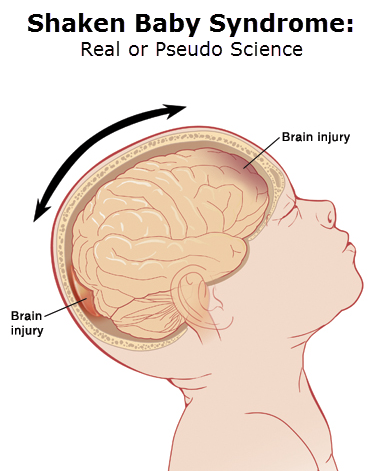
In March of 2014, a Yolo County jury returned with a verdict of not guilty on two charges involving the tragic death of a three-month-old baby. In this case, the father, Quentin Stone, was accused of shaking the baby to death and faced felony charges in connection with the baby’s death in September 2012.
The prosecution focused the jury on the serious injuries that their experts testified caused the death of the young baby. One by one, day after day, these experts would testify to what they saw in the X-rays, blood work, and what was found in the autopsy.
The prosecution’s case was based on the notion that the injuries were a direct result of shaking the baby violently on more than one occasion. However, the science of shaken baby syndrome has been called into question in recent years.
The key prosecution expert, Dr. Bennet Omalu, testified that there was no doubt that the baby died of a severe traumatic brain injury.
He would testify, “Sam’s injuries were not sustained from a fall. It was non-accidental. An infant’s motor abilities are very small and the injuries incurred would require a lot of mass and  energy.”
energy.”
However, Dr. John Plunkett, a critic of shaken-baby theory, would testify a few days later that it is was just as likely that Samuel’s injuries resulted from a fall from a three-foot-high bed onto the hardwood floor.
In his book that was just released, Mark Godsey, a former federal prosecutor who now works for the Ohio Innocence Project, writes, “For the past two decades, hundreds if not thousands of people in this country have been convicted based on a medical theory that we now know is invalid and can lead to wrongful convictions.
“This medical theory stated that if a dead or severely injured infant is reported to the hospital with three specific symptoms—bleeding in the retinas of the eyes, bleeding under the dural matter of the brain (subdural hematoma), and brain swelling—then the baby had to have been shaken by a caretaker.
“Only intense shaking, the theory went, could cause those three symptoms to be present at the same time. So if a parent or a babysitter called 911 when an infant lost consciousness, and it was later determined that those three symptoms were present, whoever was caring for the infant at the time would be charged and likely convicted of murder (or assault if the baby lived) for allegedly shaking the baby.”
However, we now understand that “various conditions and illnesses can cause these three symptoms.
“Short falls” he said, “such as falling off a couch or diaper-changing table—can cause these symptoms as well in some circumstances.”
Radley Balko in a February 21, 2014, article writes, “For years, expert witnesses told jurors that if a deceased infant has a series of symptoms—bleeding at the back of the eye, bleeding in the protective area of the brain and brain swelling—then the child died from vigorous shaking. Typically, they’d state that the victim couldn’t have died from anything else.”
However, Professor Godsey writes that “many individuals charged with murder under this theory have been acquitted in recent years, if they have had the funds to pay for medical experts to dispute the prosecution’s experts espousing the shaken baby syndrome theory.”
That doesn’t mean that people have not caused infants deaths through shaking babies. The problem is that the system is not well set up to deal with competing medical testimony.
“The science has shifted. In recent years, there has been a growing consensus among experts that the neurological symptoms once viewed as conclusive evidence of abuse may well have natural causes, and that old brain injuries can re-bleed upon little or no impact,” wrote Northwestern University Professor of Law Deborah Tuerkheimer. “Current science raises significant questions about the guilt of many caregivers convicted of shaking babies.”
The problem is, “Our legal system has been slow to absorb this new reality. As a consequence, innocent parents and caregivers remain incarcerated and, perhaps more inexplicably, prosecutions based solely on the ‘triad’ symptoms continue even to this day. The cautionary tale of Shaken Baby Syndrome shows that our system is too inclined to stay the course, and awful injustices can result.”
As Radley Balko put it, “Things get murkier when the question isn’t who committed the crime, but if a crime was committed at all.”
He notes, “The new research into SBS doesn’t state definitively that without external injuries, a child couldn’t have died from shaking. It suggests only that there are other possibilities—that shaking wasn’t the only possible cause of death. It isn’t an advance in science that will produce dispositive exonerations. It’s an advance that merely calls prior convictions into question.”
As he writes, “We haven’t yet found an adequate way to deal with that. DNA testing has forced the courts to admit when the criminal justice system definitely got it wrong. But the courts are much less likely to take action when new research suggests the system might have made an error.”
Mr. Balko concludes, “Now that we know that the criminal justice system is prone to error, perhaps it’s time to revisit the post-conviction emphasis on finality, particularly in cases decided on evidence that science later calls into doubt.”
By all measures, Quentin Stone is fortunate. The Yolo County Public Defenders’ office had the resources to pay for experts, and Monica Brushia and Martha Sequeira were able to get the jury narrowly to acquit. The science advanced far enough with our understanding of SBS for the defense to raise counter-evidence that was enough to produce reasonable doubt and acquittal.
But SBS is both a problem for the legal system in general and a cautionary tale about unproven scientific theories.
On November 4, Ms. Brushia will be at the Vanguard event to talk about the issue of shaken baby and this trial. Tickets are available here.
—David M. Greenwald reporting





